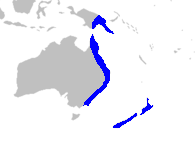Ripogonum facts for kids
Quick facts for kids Ripogonum |
|
|---|---|
 |
|
| Ripogonum scandens in New Zealand | |
| Scientific classification |
|
| Kingdom: | Plantae |
| Clade: | Tracheophytes |
| Clade: | Angiosperms |
| Clade: | Monocots |
| Order: | Liliales |
| Family: | Ripogonaceae Conran & Clifford |
| Genus: | Ripogonum J.R.Forst. & G.Forst. |
| Type species | |
| Ripogonum scandens J.R.Forst. & G.Forst.
|
|
| Species | |
|
See text |
|
 |
|
| Ripogonum distribution map | |
Ripogonum is a group of flowering plants found only in eastern Australia, New Zealand, and New Guinea. These plants are often called "supplejack" because their long stems are very flexible.
For a long time, Ripogonum was thought to be part of the Smilacaceae family, and even earlier, the Liliaceae family. But now, scientists have given it its very own family called Ripogonaceae. Most Ripogonum plants are woody vines, similar to many plants in the Smilacaceae family. However, Ripogonum has some key differences, like not having small leaf-like parts called stipules, and its seeds and leaves contain starch.
Contents
What Does Ripogonum Look Like?
The six different types of Ripogonum are perennial plants. This means they live for more than two years. They can grow as vines that climb or as shrubs. Their leaves do not have stipules. Some of their stems might have prickles, which are like small, sharp points.
The flowers of Ripogonum plants are usually white, pale green, or yellow. Each flower has six petal-like parts called tepals. The fruit is a berry that contains a few brown seeds.
The Story of Ripogonum's Name
In 1769, during explorer Lieutenant James Cook's first trip, botanists Joseph Banks and Daniel Solander found "supplejack" plants (which is Ripogonum scandens) in New Zealand. Cook visited New Zealand again in 1773. He wrote in his journal about how thick the supplejack vines were, saying they could be "fifty or sixty fathoms long" (a fathom is about 6 feet!).
During this second trip, naturalists Johann Reinhold Forster and his son Georg Forster also collected plants. The elder Forster described the plant as "a kind of climbing plant called the supple Jack by our Sailors, on account of its pliancy." He noted it had red berries and could climb very tall trees.
In 1776, the Forsters officially named the genus Ripogonum. The name comes from two Greek words: rhipos, meaning "wickerwork" (because of the long, flexible shoots), and gonu, meaning "jointed" (because the stems look like they have joints).
Ripogonum Species
There are six known types of Ripogonum plants. Most of them are found in Australia, but one is special to New Zealand.
- Ripogonum album (White supplejack) – Found in Australia (Queensland, New South Wales, Victoria) and New Guinea.
- Ripogonum brevifolium (Small-leaved supplejack) – Found in Australia (Queensland and New South Wales).
- Ripogonum discolor (Prickly supplejack) – Found in Australia (Queensland and New South Wales).
- Ripogonum elseyanum (Hairy supplejack) – Found in Australia (Queensland and New South Wales).
- Ripogonum fawcettianum (Small supplejack) – Found in Australia (Queensland and New South Wales).
- Ripogonum scandens (Supplejack) – This is the only species found in New Zealand.
How People Use Ripogonum
Some types of Ripogonum are used by indigenous peoples to make things like baskets, ropes, and traps for catching fish. In Australia and New Zealand, the berries of Ripogonum plants are a food source for some mammals and birds.
The New Zealand supplejack, Ripogonum scandens, has a root that is full of starch. This root has been used to flavor beer. The Māori of New Zealand call this plant kareao or pirita. They made a strong drink from the root that tasted a bit like sarsaparilla. This drink was used to soothe throats and help with stomach problems, fevers, and skin issues. The small berries can be eaten, though they are not very tasty. The young shoots, when cooked, are said to taste like fresh green beans. Even the sap from the plant can be eaten!
Images for kids



